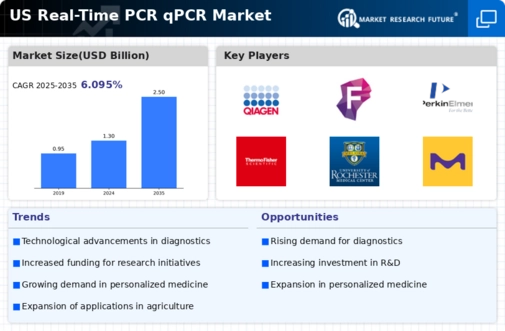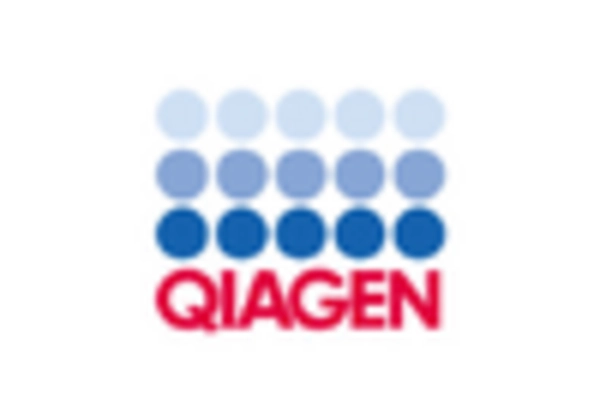Advancements in Research and Development
Ongoing advancements in research and development within the life sciences sector are significantly influencing the real time-pcr-qpcr market. Innovations in assay design, reagent formulation, and instrument capabilities are enhancing the efficiency and accuracy of PCR techniques. The US government has invested heavily in biotechnology research, which has led to the emergence of novel applications for real time PCR and qPCR technologies. This investment is expected to drive market growth, with estimates suggesting an increase in R&D spending by 15% annually. The real time-pcr-qpcr market is likely to see a proliferation of new products and applications, further expanding its reach in diagnostics and research.
Rising Prevalence of Infectious Diseases
The increasing incidence of infectious diseases in the US is a primary driver for the real time-pcr-qpcr market. As healthcare providers seek rapid and accurate diagnostic tools, the demand for real time PCR and qPCR technologies is expected to surge. According to recent data, the market is projected to grow at a CAGR of approximately 10% over the next five years. This growth is largely attributed to the need for timely detection of pathogens, which is critical in managing outbreaks and ensuring effective treatment. The real time-pcr-qpcr market is thus positioned to benefit from heightened awareness and proactive measures taken by healthcare systems to combat infectious diseases.
Growing Adoption in Personalized Medicine
The shift towards personalized medicine is reshaping the landscape of the real time-pcr-qpcr market. As healthcare providers increasingly utilize genetic information to tailor treatments, the demand for precise diagnostic tools has escalated. Real time PCR and qPCR technologies are integral in identifying genetic markers and mutations, which are essential for developing personalized treatment plans. The market is anticipated to witness a growth rate of around 12% as more healthcare institutions adopt these technologies. The real time-pcr-qpcr market is thus becoming a cornerstone in the evolution of personalized healthcare, enabling more effective and targeted therapies.
Regulatory Support and Funding Initiatives
Regulatory support and funding initiatives from the US government are pivotal in propelling the real time-pcr-qpcr market. Agencies such as the FDA are streamlining the approval processes for diagnostic tests, which encourages innovation and market entry. Additionally, federal funding for public health initiatives has increased, providing resources for the development and deployment of advanced diagnostic technologies. This supportive environment is expected to foster a robust growth trajectory for the market, with projections indicating a potential increase in market size by 20% over the next few years. The real time-pcr-qpcr market is thus well-positioned to capitalize on these favorable conditions.
Integration of Automation and AI Technologies
The integration of automation and artificial intelligence (AI) technologies into laboratory processes is transforming the real time-pcr-qpcr market. Automation enhances throughput and reduces human error, while AI algorithms improve data analysis and interpretation. This technological convergence is likely to streamline workflows in laboratories, making real time PCR and qPCR applications more efficient. Market analysts predict that the adoption of these technologies could lead to a 25% increase in operational efficiency within the next few years. The real time-pcr-qpcr market is therefore on the cusp of a technological revolution that promises to enhance diagnostic capabilities and laboratory productivity.

















Leave a Comment